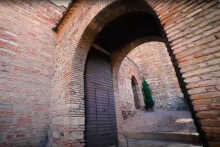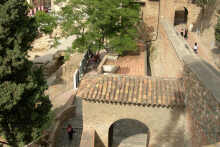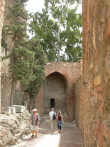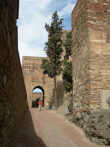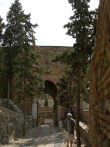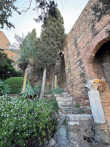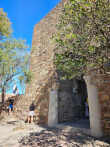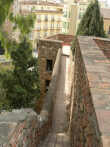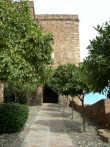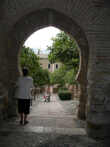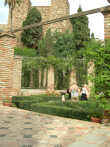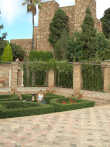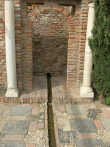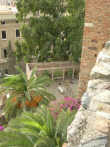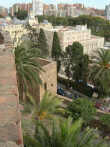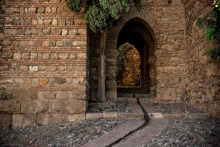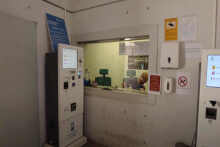Alcazaba Castle & Palace Introduction
Malaga, Costa del Sol, Spain
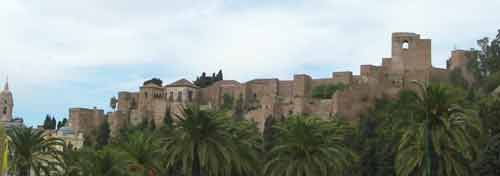
La Alcazaba a fortress & Palace
La Alcazaba fortress & Palace built in 1065 the fortifications were built by the Moors vastly improving the earlier fortifications by the Phoenicians & Romans.
The Alcazaba is probably the most important castle that remains from the Arab occupation of Spain.
The fortress is built in typical Moorish style with 2 concentric walls. The main entrance is a maze of additional walls passage ways and several gates to guard the way in.
There was a third concentric wall & also the Town wall both no longer exist.
Inside the inner ring of the 2 walls, on the upper levels, the palaces for the Arab rulers were constructed
In the early 1930s it was declared a national monument and luckily The Alcazaba was then restored, to the magnificent state it is now in.
Opening Times: 9am 6pm
Near the La Alcazaba entrance is an Archaeological Museum and the ruins of the Roman Theatre (Teatro Romano)
At a later date the Castillo de Gibralfar was also built by the Moors, on a much higher summit of the hill with a corridor of walls running down the hill to join the 2 castles. This provided protection from attack by canon fire from the hillside above La Alcazaba
Note that these 2 castles are separate monuments with separate entrances and entry fees, or a combined entrance fee for both castles is available at a reduced price
On the Open top sightseeing bus route stop number 10.
Entrances to Malaga Alcazaba & Palace Malaga Entrances
There are 2 entrances into the Alcazaba Castle & Palace
- The Main Way in
- The Lift Way in
Main Entrance
Photographs just before the Main Entrance to the Castle.
Location of Main Entrance
- From the highest corner of the very large square building of the Malaga Museum walk uphill up the slope with occasional steps, or the flight of steps, both located between the Tourist Information office kiosk & the Castle corner tower, At the top is the ticket office and entrance/exit.
- C/ Alcazabilla, 2, Distrito Centro, 29012 Málaga, Spain
0a. The First Gate
0b. The Second Gate
1. Vault Gate (Puerta de la Bóveda)
This is the first MAIN defensive gate house, and located in the Outer Main Wall
.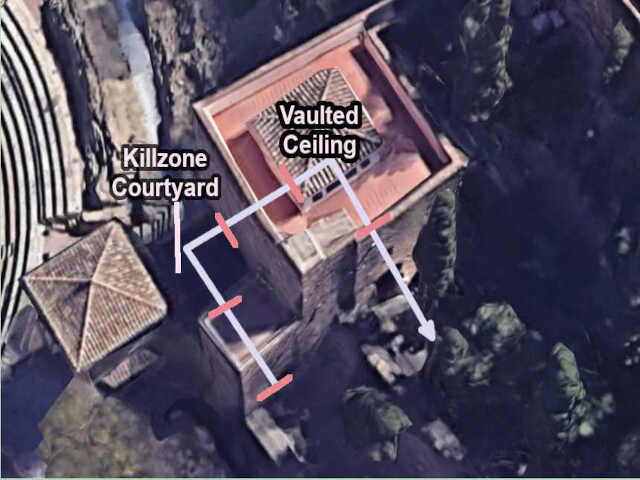
Route through the Vault Gate House & locations for 5 gates
- There are locations for 5 Gates,short red lines in the above photo, diagram, and an open top 'kill zone' courtyard within the gatehouse system.
- The steep approach path, is continued through the system and also a total of 5 steps which makes the exit far higher than the entrance.
- You also make 2 right hand turns ie a U turn, as you pass through. Turns in or after y & helps to disorient attackers and helps prevent the further access of siege engines such a battering rams.
- When in inside the gate house make sure you look up & view the amazing brick vaulted dome ceiling. It has a circular pattern of bricks , changing to an herring bone pattern in the centre
4 Columns Gate (Puerta de las Columnas)
- The columns Gate house has 4 recovered miss matching Roman Columns also with miss matching Plinths on the entry & exit.
- You will see Roman Columns throughout the Alcazaba, but these are the largest.
- After you pass through the gatehouse you have a choice of 2 routes
- Follow the main path or
- Turn right & go up the steps in the corner to:
- Visit the Battlements of the Albarrana Tower and see great views & how this tower dominates the approach to the entrance way. This is the only tower with roof access.
- And / or walk along the parapet for more views over the city & sea. You rejoin the main path at the next tower.
4a. Albarrana Tower
- The Albarrana Tower is the only tower like it. The tower juts out into the City, like your arm juts out from your body. Your hand being the tower and your arm the connecting wall being your arm.
- It's protecting the main approach to the fortification.
- It was also connected to the Malaga City Walls and the third wall of the Alcazaba, both no long in existence.
5 Gate leading to the Sea Gate (Haza de la Alcazaba)
- Outside this Gate was a bailey and the Third Wall which went down to the sea front & harbour. All lost to modern day buildings, roads & parks.
6 Christ's Gate (Torre del Cristo)
- The uphill path to the gate is fairly steep with the slope broken by a step about every 2 to 3 metre along the pathway.
- If you are an attacker you are confined to a narrow killing zone by the high wall on your left and a high drop after the parapet on your right
- The defenders firing on you from the battlements above on your left and multiple towers on both sides.
- Roughly half way up the slope you can see the remains of an additional gatehouse.
- Once inside the Christ gate you have to turn left again this defence design feature.
- After you exit the inner gate you are in the Silo storage pits for food such as grain.
8. Underground Storage (Silo)
- Look for round holes in the ground about 750cm in diameter, covered by a locked Iron Grid.
- Below the opening is a large inverted funnel shaped hole that was dug into the rock by the romans for the storage of Garum a very popular fermented fish sauce.
- The Muslims used these Garum pits for food storage in case of siege
- Three holes over the pits can be seen in the Silo area and one more used as a dungeon. More were located in the palace level but are covered over by patios or gardens
7 Parade ground (Plaza de Armas)
- Very beautiful Patio styled Garden with Fountains, brick column Pergola with climbing plants, great views, water features, potted plants, sunken & raised sections
9 Gate of the Halls of Granada (Puerta de los Cuartos de Granada)
- A central water channel runs along the floor of this 2 gate Gatehouse
- In the centre of the gatehouse is a very large Murder Hole where the defenders could throw down anything lethal onto the attackers from their position on the roof..
- Once through this gatehouse you are inside the inner wall, the heart of the Alcasaba fortress
- On your right is a drinking fountain with the water spot exiting through a fishes mouth.. NOT SAFE TO DRINK
- Turn right, straight forward is a coat of arms high on the wall
- Now turn right and pass through an arch, a possible gate location, then pass a bath fountain, turn right again and go up the flight of steps to the next level , the Palace Gardens
- Both of these are in in a kind of courtyard with Zig zag exit through an archway probably with a gate followed by another right angle turn to the right to a flight of steps to a higher level a the palace Gardens.
10 Garden and Courtyard of the Jets of Water Silo, Garden and Patio de los Surtidore)

11a. Maldonado Tower (Torre de Maldonado)
11b. View area between Maldonado Tower & Armadura Mudéjar Tower
11c. Tower (Torre de la Armadura Mudéjar)
- With a beautiful carved wood Mudéjar ceiling
12 Orange Trees Courtyard Patio de los Naranjos)
13 Pool Courtyard (Patio de la Alberca)
14. Reservoir Courtyard Patio del Aljibe ()
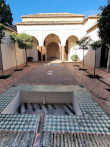
- The Courtyard is built over a large water cistern
- Currently not open to the public and the buildings used as a resurrection workshop.
- Records do not exist to show if this was part of the palace, or the dwelling buildings beyond, all under either excavation or restorations, also closed to the public.
15 11th century dwellings )
- Not open to the public
16 Homage Tower (Torre del Homenaje)
- Not open to the public
- The Tower is the Castle Keep and the tallest tower in the Alcazaba
- Good views can be seen by turning right after entering through the Christ gate go to the end take the uphill route then go up the flight of steps by the metal gate, onto the parapet.
17 Well
- Area Not open to the public
18 Dungeon
- One of the Garum pits that was on the north side of the complex had been dug in a slightly different rock strata and was damp and therefore unsuitable for food storage.
- It was therefore put to use as a very unpleasant and unscalable dungeon wall.
- It was located in the narrow outer bailey on the north side. Not open to the public.
- It can be seen from the battlements of the inner curtain wall accessed from the northern corner of the Patio de los Surtidores
19 Access to the Coracha and the Gibralfaro
- The Coracha is closed to the public.
- The Coracha was a safe narrow passage way that connected the Alcazaba Castle to the much higher up the hillside, Gibralfaro Castle.
- This passage way by a wall with parapets & battlements on both sides of it.
- It may at some time be opened to the public, but the inside will have to be renovated & made safe
- There is a pathway on the southern side outside the castles & Coracha to get to the Gibralfaro Castle, or take the 38 bus to avoid the struggle up the hill especially in the heat of summer.
- There is a pathway also on the northern side but further away from the Coracha Walls, that is less known & mainly used by locals. There are many more trees & therefore more shade, which is plus point but the views are not as good as the south side.
20 Toilets
- The toilets are located in a tower on the North side on the middle level of the Patio de los Surtidore
A. Lift to the Alcazaba Palace (Ascensor a la Alcazaba)
- The lift takes you to the Palace Area. Tickets price is the same as at the Main Entrance so the lift is free.
- The lift makes it easy for people with:
- Mobility difficulties.
- With push chairs.
- Soon tire with steep uphill walking.
- If you have taken the lift to go up, I recommend you walk down if your walking difficulties allow.
- This is so you can view the fortress in its fantastic glory and its immaculate defences that held at bay an army of 80,000 for almost 4 months, until starved into surrender.
- Occasionally the lift is out of order. If you rely on this method I recommend you telephone to check if it operating.
B. Location of the Lift
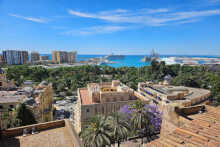
The lift entrance is opposite the dome on the Town Hall, the left building. One of the many dramatic views from the castle carpets.
- The lift is located opposite the corner of the Town Hall in C. Guillén Sotelo
- There is a long straight tunnel that takes you to the tunnel ticket office and/or ticket machines
Brief History of the Malaga Alcazaba
755 AD First Malaga Fortifications by the Moors
- Abd al-Rahman I, the first ruler(Emir) of Cordoba built the first defensive fortifications over previous Roman remains on the Gibralfaro hill. These were built as defence again Pirate raids.
From 1057 Rebuilding
- Badis Al-Ziri, The Sultan of Granada rebuilt & strengthened the fortifications
1487 Siege & Capture of the Walled Town & 2 Castles
- In 1487 the Catholic monarchs, Isabella I of Castile and Ferdinand II of Aragon with an army of 80,000 attacked the fortress defended by 15,000 Moors, a numerical advantage of over 5 to 1.
- The town was captured after an almost 4 month siege, in 1487. The towns occupants were found to be almost starved to death.
- Due to Starvation the Alcazaba surrendered a couple of days later, and the Gibralfaro after a few more days
- The Catholic monarchs, Isabella I of Castile and Ferdinand II of Aragon, lived in the Alcazaba
- King Philip IV,1268-1314, was a guest there.
- Because the defenders had refused surrender on several occasions the Catholic Monarchs were not merciful to the captors and the vast majority of them were either killed or sold into slavery.
Book a guided Tour
- We have 3 options for you
Alcazaba Malaga Guided Tour
Our Quick Guide. See The Advertisers Page for any corrections or updates.
- A 1 hour 20minutes (approx.) tour of The Alcazaba Castle & the Arab Palace.
- Highly recommended
- In English & 1 other language
- Meet at the glass pyramid in front of the Roman Theatre.
- Not wheelchair accessible
- Maximum of 25 visitors
Malaga Tour with Alcazaba, Cathedral, and Roman Theatre
Our Quick Guide. See The Advertisers Page for any corrections or updates.
- 3 hours (approx.)
- In English & 1 other language
- Visit the Málaga.
- Cathedral. 1 hour
- Roman Theatre. 30 minutes
- Alcazaba 1 hour 30 minutes
- Some of the Streets in the Malaga Historic Centre
- Meet at the glass pyramid in front of the Roman Theatre .End at Santa Iglesia Catedral Basílica de la Encarnación
- Not wheelchair accessible
- Not recommended for travellers with back problems, pregnant travellers, travellers with heart problems or other serious medical conditions
Malaga Walking Tour, Gibralfaro, Alcazaba & Catamaran Cruise
Ultimate Malaga History & Tapas - All Included Full Experience


